Comparative Study of the Es Layer between the Plateau and Plain Regions in China
Abstract
:1. Introduction
2. Data Sets and Methodology
3. Observations and Results
3.1. Comparison of Diurnal Changes in Es Layer
3.2. Comparison of Seasonal Changes in Es Layer
3.3. Es Layer Changes with Month and Local Time
4. Discussion
5. Conclusions
- (1)
- The diurnal characteristics of the occurrence probability in the Es layer are similar at the Beijing and Zhangye stations, with a maximum value at noontime. However, during the post-midnight period in winter, the Es layer occurred more frequently at Zhangye station than at Beijing. In terms of the intensity of the Es layer (foEs), there is a large discrepancy between the two stations. The maximum mean value of foEs occurred at nighttime at Zhangye (from Figure 9d and Figure 10), inconsistent with the observations from Beijing station. There is an obvious night anomaly in the intensity of the Es layer at Zhangye.
- (2)
- The seasonal variations in the occurrence probability of the Es layer at Beijing and Zhangye are similar (the maximum summer). The occurrence of the Es layer at Zhangye is higher than Beijing throughout the year (except May). The discrepancy in the occurrence of the Es layer between the two stations is larger in winter and early spring and smaller in summer. In terms of the monthly mean of foEs, the maxima are in summer at Zhangye and Beijing stations. However, in winter and early spring, the mean values of foEs at Zhangye station are slightly larger than that at Beijing station, but the opposite in other seasons. In terms of the daily mean value of foEs, the maximum daily mean value occurred in winter at Zhangye station. In terms of the occurrence probability and intensity of Es, there is pronounced anomaly (post-midnight) at Zhangye compared with the observations from Beijing station.
- (3)
- The anomalies of the Es layer at night and in winter to spring at Zhangye station might be attributed to the gravity wave activity in the Qinghai–Tibet Plateau. The power spectrum of gravity waves in the Qinghai–Tibet Plateau is weakest at noontime and strongest at midnight. The diurnal variations are consistent with the night anomaly of the Es layer at Zhangye station. The strength of the gravity waves is stronger in winter and spring than in summer and autumn. We found that the seasonal characteristics of the gravity waves are also consistent with the winter anomaly of the Es layer at Zhangye station.
Author Contributions
Funding
Data Availability Statement
Acknowledgments
Conflicts of Interest
References
- Houminer, Z.; Russel, C.J.; Dyson, P.L.; Bennet, J.A. Study of sporadic-E clouds by backscatter radar. Ann. Geophys. 1996, 14, 1060–1065. [Google Scholar] [CrossRef]
- Raizada, S.; Tepley, C.A.; Zhou, Q.; Sarkhel, S.; Mathews, J.D.; Aponte, N.A.; Cabassa, E. Dependence of mesospheric Na and Fe distributions on electron density at Arecibo. Earth Planets Space 2015, 67, 146. [Google Scholar] [CrossRef] [Green Version]
- Wei, L.; Jiang, C.; Hu, Y.; Aa, E.; Huang, W.; Liu, J.; Yang, G.; Zhao, Z. Ionosonde Observations of Spread F and Spread Es at Low and Middle Latitudes during the Recovery Phase of the 7–9 September 2017 Geomagnetic Storm. Remote Sens. 2021, 13, 1010. [Google Scholar] [CrossRef]
- Whitehead, J.D. The formation of the sporadic E layer in the temperate zones. J. Atmos. Sol. Terr. Phys. 1961, 20, 49–58. [Google Scholar] [CrossRef]
- Axford, W.I. The formation and vertical movement of dense ionized layers in the ionosphere. J. Geophys. Res. 1963, 68, 769–779. [Google Scholar] [CrossRef]
- Whitehead, J.D. Production and prediction of sporadic-E. J. Rev. Geophys. 1970, 8, 65–144. [Google Scholar] [CrossRef]
- Whitehead, J.D. Recent work on mid-latitude and equatorial sporadic-E. J. Atmos. Terr. Phys. 1989, 51, 401–424. [Google Scholar] [CrossRef]
- Mathews, J.D. Sporadic E: Current views and recent progress. J. Atmos. Sol. Terr. Phys. 1998, 60, 413–435. [Google Scholar] [CrossRef]
- Haldoupis, C.; Pancheva, D. Planetary waves and midlatitude sporadic E layers: Strong experimental evidence for a close relationship. J. Geophys. Res. 2002, 107, A6. [Google Scholar] [CrossRef]
- Pancheva, D.; Haldoupis, C.; Meek, C.E.; Manson, A.H.; Mitchell, N.J. Evidence of a role for modulated atmospheric tides in the dependence of sporadic E layers on planetary waves. J. Geophys. Res. 2003, 108, 1176. [Google Scholar] [CrossRef]
- Arras, C.; Jacobi, C.; Wickert, J. Semidiurnal tidal signature in sporadic E occurrence rates derived from GPS radio occultation measurements at higher midlatitudes. Ann. Geophys. 2009, 27, 2555–2563. [Google Scholar] [CrossRef] [Green Version]
- Zhou, C.; Tang, Q.; Song, X.X.; Qing, H.Y.; Liu, Y.; Wang, X.; Gu, X.D.; Ni, B.B.; Zhao, Z.Y. A statistical analysis of sporadic E layer occurrence in the midlatitude China region. J. Geophys. Res. 2017, 122, 3617–3631. [Google Scholar] [CrossRef]
- Haldoupis, C.; Pancheva, D.D. Terdiurnal tidelike variability in sporadic E layers. J. Geophys. Res. 2006, 11, A07303. [Google Scholar] [CrossRef]
- Haldoupis, C.; Meek, C.; Christakis, N.; Pancheva, D.; Bourdillon, A. Lonogram height-time-intensity observations of descending sporadic E layers at mid-latitude. J. Atmos. Sol. Terr. Phys. 2006, 68, 539–557. [Google Scholar] [CrossRef] [Green Version]
- Arras, C.; Wickert, J.; Beyerle, G.; Heise, S.; Schmidt, T.; Jacobi, C. A global climatology of ionospheric irregularities derived from GPS radio occultation. Geophys. Res. Lett. 2008, 35, 14. [Google Scholar] [CrossRef]
- Haldoupis, C.; Pancheva, D.; Singer, W.; Meek, C.; MacDougall, J. An explanation for the seasonal dependence of midlatitude sporadic E layers. J. Geophys. Res. Space Phys. 2007, 112, A06315. [Google Scholar] [CrossRef]
- Dou, X.K.; Qiu, S.C.; Xue, X.H.; Chen, T.D.; Ning, B.Q. Sporadic and thermospheric enhanced sodium layers observed by a lidar chain over China. J. Geophys. Res. Space Phys. 2013, 118, 6627–6643. [Google Scholar] [CrossRef]
- Williams, B.P.; Berkey, F.T.; Sherman, J.; She, C.Y. Coincident extremely large sporadic sodium and sporadic E layers observed in the lower thermosphere over Colorado and Utah. Ann. Geophys. 2007, 25, 3–8. [Google Scholar] [CrossRef] [Green Version]
- Pietrella, M.; Bianchi, C. Occurrence of sporadic-E layer over the ionospheric station of Rome: Analysis of data for thirty-two years. Adv. Space Res. 2009, 44, 72–81. [Google Scholar] [CrossRef]
- Yu, B.; Xue, X.; Yue, X.; Yang, C.; Yu, C.; Dou, X.; Ning, B.; Hu, L. The global climatology of the intensity of the ionospheric sporadic E layer. Atmos. Chem. Phys. 2019, 19, 4139–4151. [Google Scholar] [CrossRef] [Green Version]
- Pietrella, M.; Pezzopane, M.; Bianchi, C. A comparative sporadic-E layer study between two mid-latitude ionospheric stations. Adv. Space Res. 2014, 54, 150–160. [Google Scholar] [CrossRef]
- Reinisch, B.W.; Galkin, I.A.; Khmyrov, G.M.; Kozlov, A.V.; Lisysyan, I.A.; Bibl, K.; Cheney, G.; Kitrosser, D.F.; Stelmash, S.; Roche, K.; et al. Advancing Digisonde technology: The DPS-4D, in Radio Sounding and Plasma Physics. AIP Conf. Proc. 2008, 974, 127–143. [Google Scholar] [CrossRef]
- Shi, S.; Yang, G.; Jiang, C.; Zhang, Y.; Zhao, Z. Wuhan Ionospheric Oblique Backscattering Sounding System and Its Applications—A Review. Sensors 2016, 17, 1430. [Google Scholar] [CrossRef] [Green Version]
- Matsushita, S.; Reddy, C.A. A study of blanketing sporadic E at middle latitudes. J. Geophys. Res. 1967, 72, 2903–2916. [Google Scholar] [CrossRef]
- Cai, X.; Yuan, T.; Eccles, J.V.; Raizada, S. Investigation on the distinct nocturnal secondary sodium layer behavior above 95 km in winter and summer over Logan, UT (41.7°N, 112°W) and Arecibo Observatory, PR (18.3°N, 67°W). J. Geophys. Res. Space Phys. 2019, 124, 9610–9625. [Google Scholar] [CrossRef]
- Chu, Y.; Wang, C.; Wu, K.; Chen, K.; Tzeng, K.J.; Su, C.; Feng, W.; Plane, J.M.C. Morphology of sporadic E layer retrieved from COSMIC GPS radio occultation measurements: Wind shear theory examination. J. Geophys. Res. Space 2014, 119, 2117–2136. [Google Scholar] [CrossRef]
- Plane, J.M.C.; Feng, W.; Dawkins, E.C.M. The Mesosphere and Metals. Chem. Chang. Chem. Rev. 2015, 115, 4497–4541. [Google Scholar] [CrossRef] [PubMed]
- Dou, X.-K.; Xue, X.-H.; Li, T.; Chen, T.-D.; Chen, C.; Qiu, S.-C. Possible relations between meteors, enhanced electron density layers, and sporadic sodium layers. J. Geophys. Res. Space Phys. 2010, 115, A6. [Google Scholar] [CrossRef] [Green Version]
- MacDougall, J.W. 110 km neutral zonal wind patterns. Planet. Space Sci. 1974, 22, 545–558. [Google Scholar] [CrossRef]
- Wilkinson, P.J.; Szuszczewicz, E.P.; Roble, R.G. Measurements and modelling of intermediate, descending, and sporadic layers in the lower ionosphere: Results and implications for global-scale ionosphericthermospheric studies. Geophys. Res. Lett. 1992, 19, 95–98. [Google Scholar] [CrossRef]
- Haldoupis, C. Midlatitude sporadic E. A typical paradigm of atmosphereionosphere coupling. Space Sci. Rev. 2012, 168, 441–461. [Google Scholar] [CrossRef]
- Liu, Y.; Zhou, C.; Xu, T.; Tang, Q.; Deng, Z.X.; Chen, G.Y.; Wang, Z.K. Review of ionospheric irregularities and ionospheric electrodynamic coupling in the middle latitude region. Earth Planet. Phys. 2021, 5, 462–482. [Google Scholar] [CrossRef]
- Didebulidze, G.G.; Dalakishvili, G.; Todua, M. Formation of Multilayered Sporadic E under an Influence of Atmospheric Gravity Waves (AGWs). Atmosphere 2020, 11, 653. [Google Scholar] [CrossRef]
- Yao, Z.-G.; Zhao, Z.-L.; Han, Z.-G. Stratospheric gravity waves during summer over East Asia derived from AIRS observations. Chin. J. Geophys. 2015, 58, 1121–1134. [Google Scholar] [CrossRef]
- Qian, T.; Zhang, F.; Wei, J.; He, J.; Lu, Y. Diurnal Characteristics of Gravity Waves over the Tibetan Plateau in 2015 Summer Using 10-km Downscaled Simulations from WRF-EnKF Regional Reanalysis. Atmosphere 2020, 11, 631. [Google Scholar] [CrossRef]
- Zeng, X.; Xue, X.; Dou, X.; Liang, C.; Jia, M. COSMIC GPS observations of topographic gravity waves in the stratosphere around the Tibetan Plateau. Sci. China Earth Sci. 2016, 60, 188–197. [Google Scholar] [CrossRef]
- Xu, X.H.; Guo, J.C.; Luo, J. Analysis of the active characteristics of stratosphere gravity waves over the Qinghai-Tibetan Plateau using COSMIC radio occultation data. Chin. J. Geophys. 2016, 59, 1199–1210. (In Chinese) [Google Scholar] [CrossRef]
- Zou, X.; Yang, G.; Wang, J.; Gong, S.; Cheng, X.; Jiao, J.; Yue, C.; Fu, H.; Wang, Z.; Yang, S.; et al. Gravity wave parameters and their seasonal variations derived from Na lidar observations at Beijing. Chin. J. Space Sci. 2015, 35, 453–460. (In Chinese) [Google Scholar] [CrossRef]
- Smith, A.K. Global dynamics of the MLT. Surv. Geophys. 2012, 33, 1177–1230. [Google Scholar] [CrossRef] [Green Version]
- Liu, X.; Yue, J.; Xu, J.; Garcia, R.R.; Russell, J.M.; Mlynczak, M.; Wu, D.L.; Nakamura, T. Variations of global gravity waves derived from 14 years of SABER temperature observations. J. Geophys. Res. Atmos. 2017, 122, 6231–6249. [Google Scholar] [CrossRef]
- Preusse, P.; Eckermann, S.D.; Ern, M.; Oberheide, J.; Picard, R.H.; Roble, R.G.; Riese, M.; Russell, J.M., III; Mlynczak, M.G. Global ray tracing simulations of the SABER gravity wave climatology. J. Geophys. Res. Atmos. 2009, 114, D8. [Google Scholar] [CrossRef]
- Xiaobin, W.; Zhengzheng, M.A.; Yabin, Z. Statistical analysis on characteristics of Es in Qingdao region. Chin. J. Radio Sci. 2014, 29, 969–972+993. (In Chinese) [Google Scholar] [CrossRef]

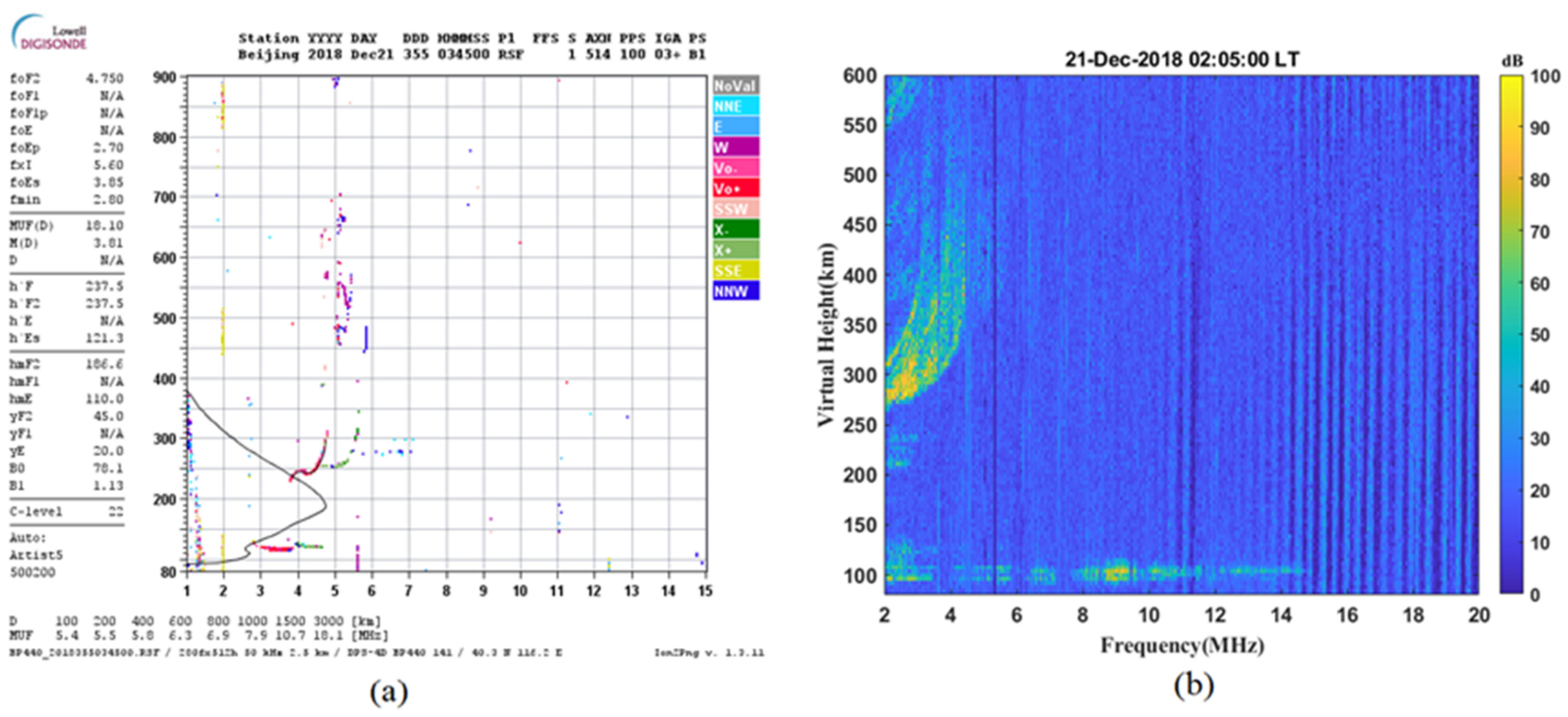
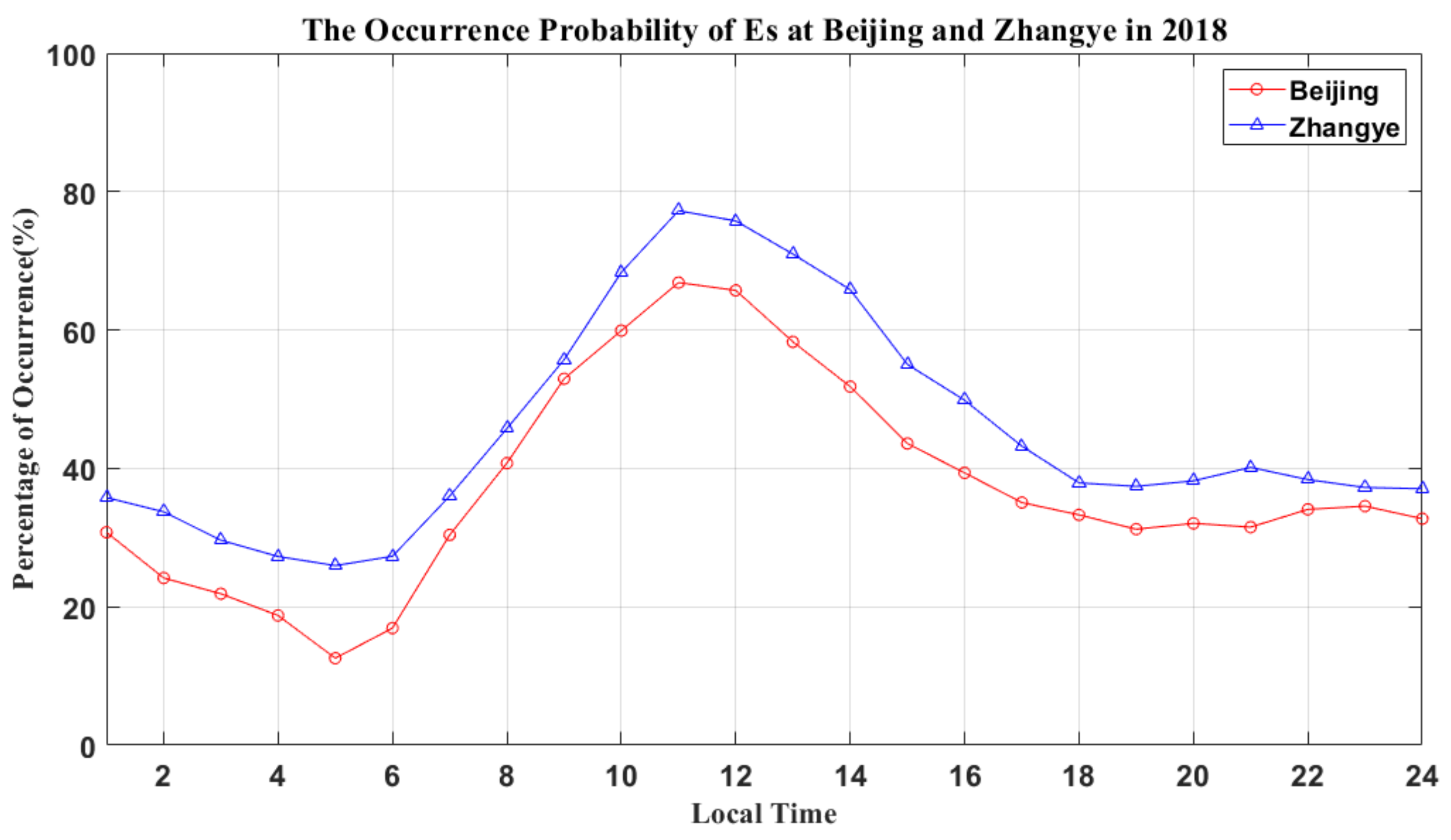


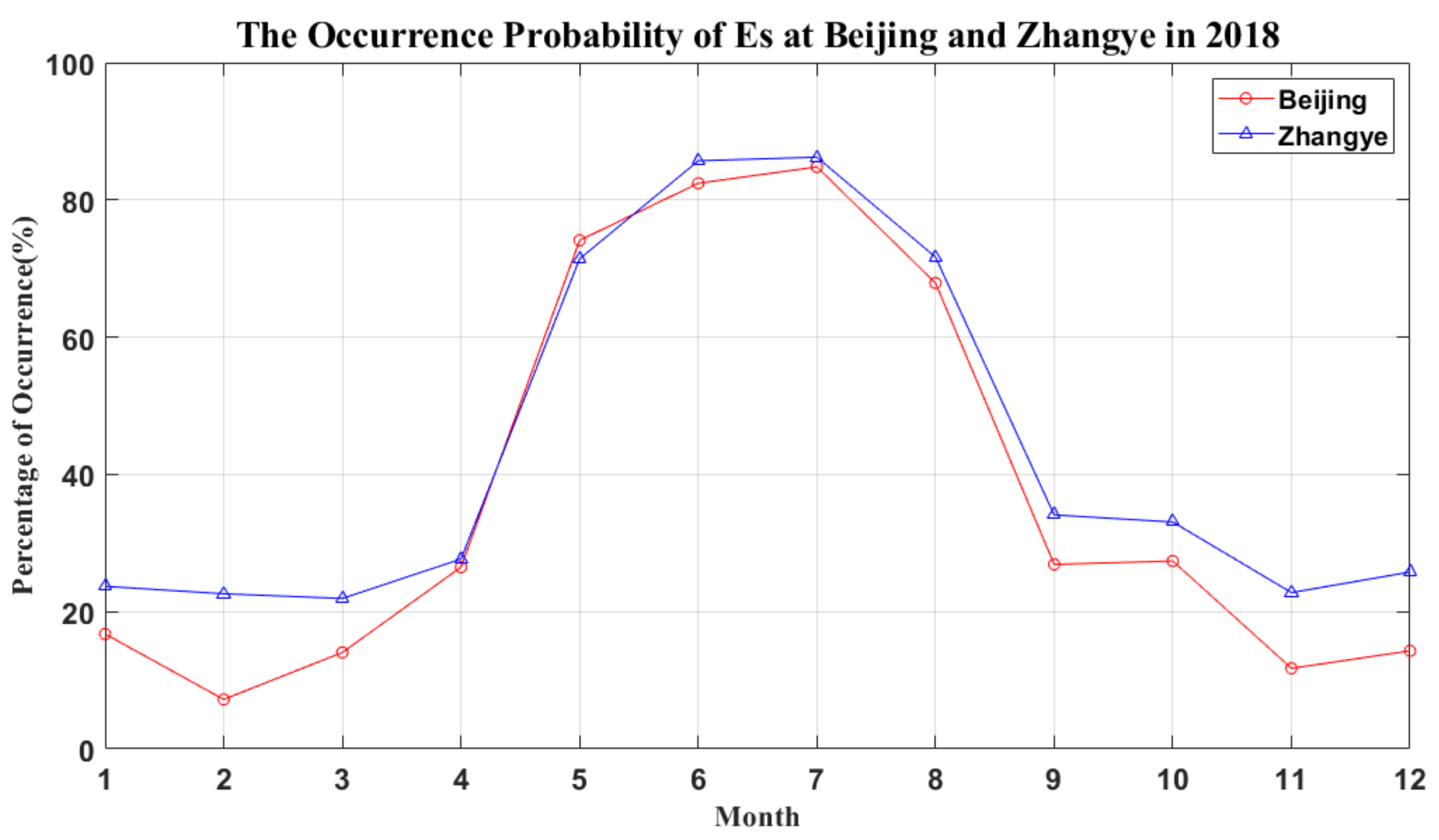
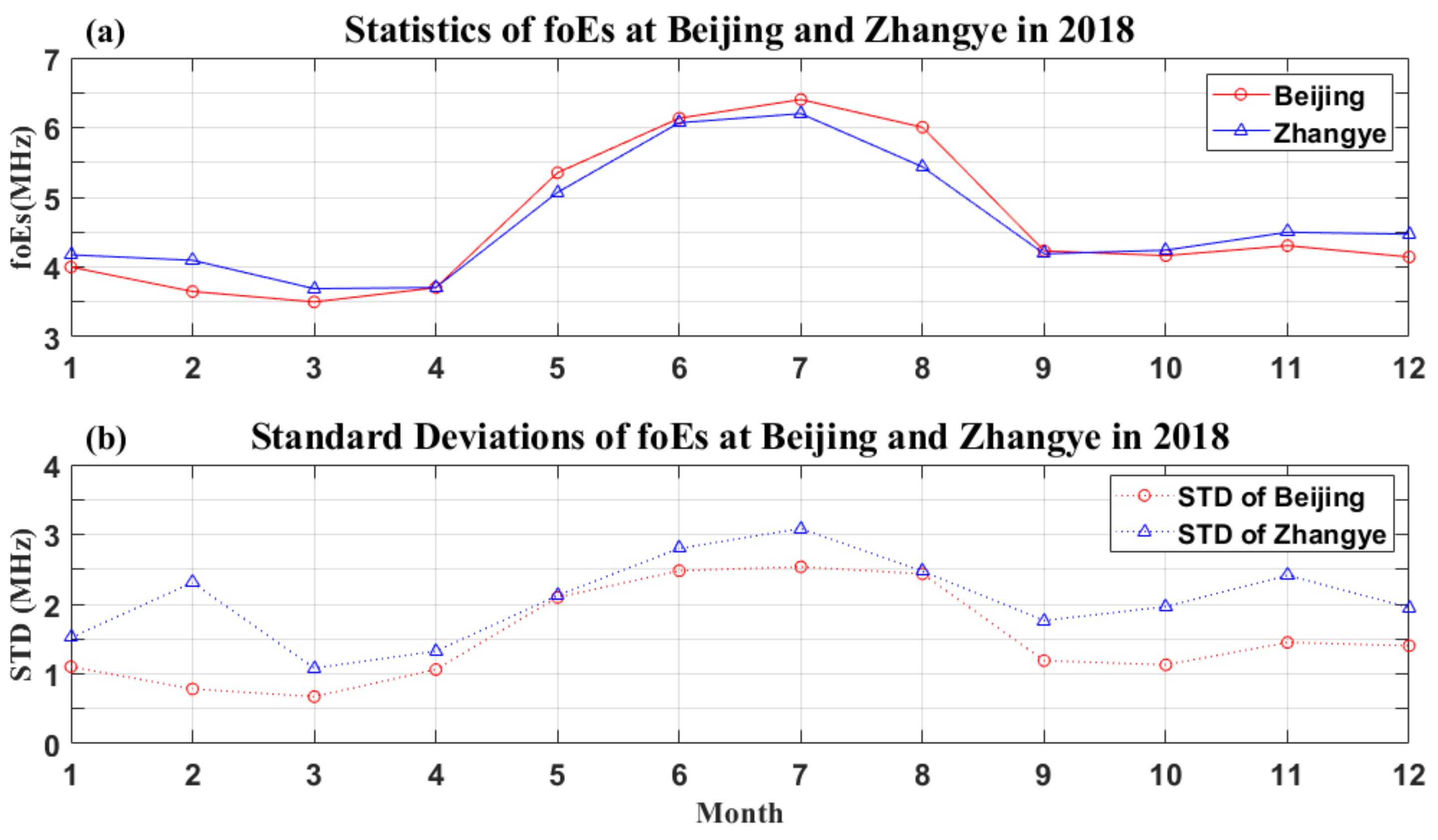

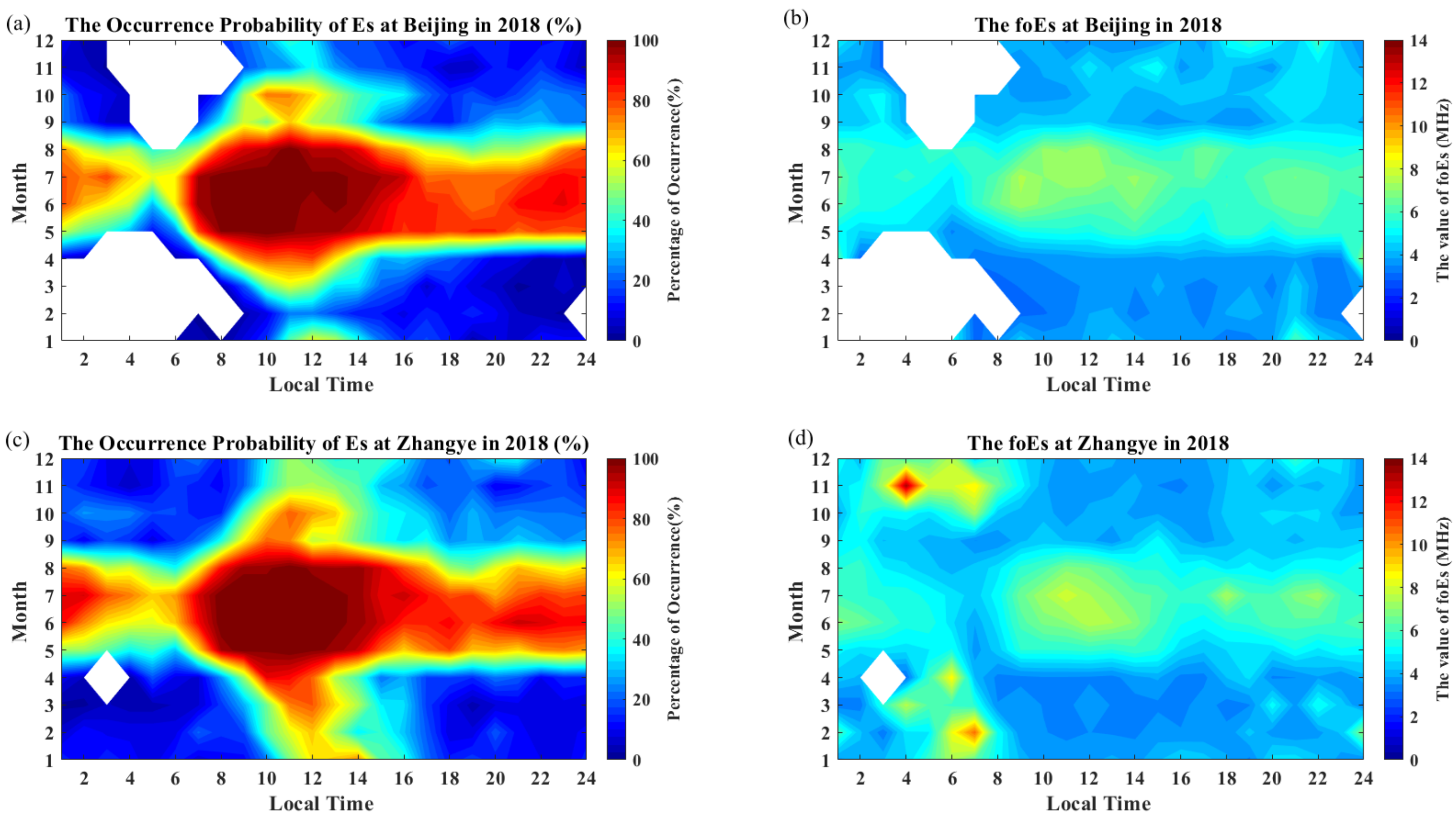


| Month | Number of Data Loss at Beijing | Data Loss Rate (%) | Number of Data Loss at Zhangye | Data Loss Rate (%) |
|---|---|---|---|---|
| 1 | 31 | 2.083 | 32 | 2.151 |
| 2 | 0 | 0 | 508 | 37.798 |
| 3 | 1 | 0.067 | 170 | 11.425 |
| 4 | 13 | 0.902 | 435 | 30.208 |
| 5 | 310 | 20.833 | 26 | 1.747 |
| 6 | 12 | 0.833 | 0 | 0 |
| 7 | 7 | 0.470 | 0 | 0 |
| 8 | 9 | 0.605 | 6 | 0.403 |
| 9 | 12 | 0.833 | 0 | 0 |
| 10 | 27 | 1.815 | 0 | 0 |
| 11 | 1 | 0.069 | 0 | 0 |
| 12 | 5 | 0.336 | 2 | 0.134 |
| Total | 428 | 2.443 | 1179 | 6.729 |
Publisher’s Note: MDPI stays neutral with regard to jurisdictional claims in published maps and institutional affiliations. |
© 2022 by the authors. Licensee MDPI, Basel, Switzerland. This article is an open access article distributed under the terms and conditions of the Creative Commons Attribution (CC BY) license (https://creativecommons.org/licenses/by/4.0/).
Share and Cite
Wang, W.; Jiang, C.; Wei, L.; Tang, Q.; Huang, W.; Shen, H.; Liu, T.; Yang, G.; Zhou, C.; Zhao, Z. Comparative Study of the Es Layer between the Plateau and Plain Regions in China. Remote Sens. 2022, 14, 2871. https://doi.org/10.3390/rs14122871
Wang W, Jiang C, Wei L, Tang Q, Huang W, Shen H, Liu T, Yang G, Zhou C, Zhao Z. Comparative Study of the Es Layer between the Plateau and Plain Regions in China. Remote Sensing. 2022; 14(12):2871. https://doi.org/10.3390/rs14122871
Chicago/Turabian StyleWang, Wenxuan, Chunhua Jiang, Lehui Wei, Qiong Tang, Wengeng Huang, Hua Shen, Tongxin Liu, Guobin Yang, Chen Zhou, and Zhengyu Zhao. 2022. "Comparative Study of the Es Layer between the Plateau and Plain Regions in China" Remote Sensing 14, no. 12: 2871. https://doi.org/10.3390/rs14122871






